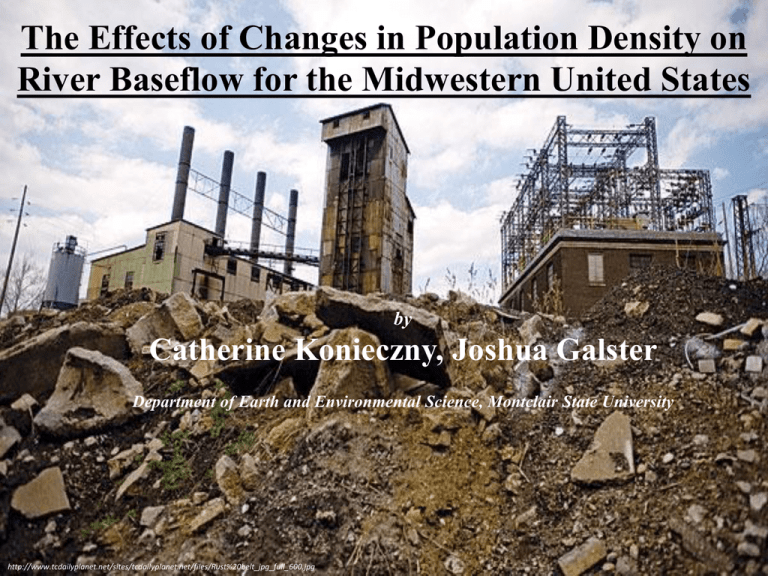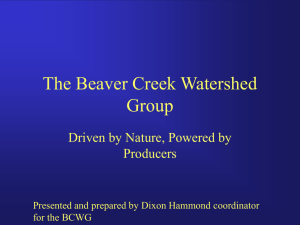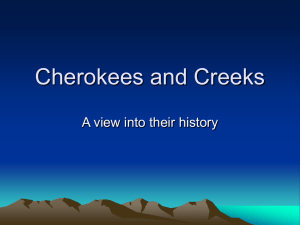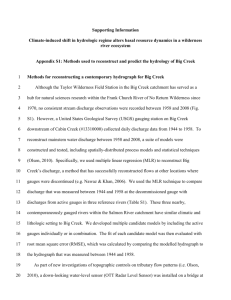Presentation1
advertisement

The Effects of Changes in Population Density on River Baseflow for the Midwestern United States by Catherine Konieczny, Joshua Galster Department of Earth and Environmental Science, Montclair State University http://www.tcdailyplanet.net/sites/tcdailyplanet.net/files/Rust%20belt_jpg_full_600.jpg Goal: Test to see if a trend exists between population density and river baseflow What constitutes as a depopulated city and where are these cities found? What is river baseflow, runoff, and total flow? (River Baseflow + Runoff = Total Flow) http://images.flatworldknowledge.com/trowbridge2_1.0/trowbridge2_1.0-fig12_001.jpg http://jan.ucc.nau.edu/~doetqp-p/courses/env302/lec6/Image41.gif How are population density and baseflow connected? http://www.beachapedia.org/images/4/46/Natural_%26_impervious_cover_diagrams_EPA.jpg Konieczny et al. (2014) Lopes et al. (2013) http://upload.wikimedia.org/wikipedia/commons/thumb/4/4d/Physiographic_Provinces_48_Conterminous_US-v1.svg/800px-Physiographic_Provinces_48_Conterminous_US-v1.svg.png Objective: Test to see if a trend exists between population density and river baseflow Steps: • Which cities are depopulating in the Midwest • Determine which gages fit the desired criteria – At least 5 to 10 gages from each state – Continuous data for at least 40 years – Drainage area of less than 400miles 2 • Collect discharge data from each gage of interest How is the goal going to be accomplished? Lim et. al, 2010 http://www.eia.gov/emeu/recs/cendivco.gif http://pubs.usgs.gov/of/1999/ofr-99-0364/usgs.gif http://upload.wikimedia.org/wikipedia/commons/f/f0/Northfield_Mountain_Tailrace_Tunnel_-_USGS_map.jpg http://upload.wikimedia.org/wikipedia/commons/thumb/6/6b/Census_Bureau_seal.svg/220px-Census_Bureau_seal.svg.png Compiling the Data Baseflow Precipitation/Area Runoff Precipitation/Area Total Flow Precipitation/Area Analyzing the Data SUMMARY OUTPUT for #4216200 LOG Pop Den vs. LOG BF/P/A Regression Statistics Multiple R 0.73947873 R Square 0.546828791 Adjusted R Square 0.533881043 Standard Error 0.139887057 Observations 37 ANOVA df SS Regression Residual Total 1 35 36 Coefficients Intercept X Variable 1 MS F 0.826441611 0.8264416 42.233503 Significance F 1.71084E-07 0.684893608 0.0195684 1.511335219 Standard Error t Stat P-value Lower 95% Upper 95% Lower 95.0% -23.92954385 2.8492442 -8.3985584 6.612E-10 -29.71381705 -18.14527065 -29.71381705 7.164849305 1.102499768 6.4987309 1.711E-07 4.926655799 9.403042812 4.926655799 • • • Results Summarized Out of 26 gages, 16 gages had statistically significant results, with a p-value equal to or less than 0.05 or 53% of gages proved to be statistically significant Only 11% of the statistically significant gages are found within the Appalachian Plateau 65% of gages in the Central Lowlands produced statistically significant results LOG Data Gage Name Gage # BF X-var p-value RO X-var p-value TF X-var p-value LITTLE PINE CREEK NEAR ETNA, PA 3049800 0.169248 0.643258 -0.04655 0.927761 0.057203 0.889731 ABERS CREEK NEAR MURRAYSVILLE, PA 3084000 0.569825 0.176394 0.446385 0.361264 0.51235 0.222733 TURTLE CREEK AT TRATTFORD, PA 3084500 -0.90586 0.193385 -1.73619 0.063137 -1.31276 0.078252 CHARTIERS CREEK AT CARNEGIE, PA 3085500 -0.05867 0.841827 -0.47766 0.032828 -0.20952 0.441274 MILL CREEK AT YOUNGSTOWN, OH 3098500 -1.50317 0.719685 -1.3767 0.602494 -1.59211 0.661382 TINKERS CREEK AT BRADFORD, OH 4207200 -0.89173 0.031647 -0.51572 0.271409 -0.71497 0.08092 MILL CREEK AT CARTHAGE, OH 3259000 1.764329 0.297274 1.284297 0.197907 1.530912 0.279303 WOLF CREEK AT DAYTON, OH 3271000 4.347494 6.15E-05 3.071518 1.98E-05 3.90621 4.35E-05 KEARSLEY CREEK NEAR DAVISON, MI 4148140 0.003405 0.996545 0.194338 0.820923 0.073458 0.926282 PAINT CREEK AT ROCHESTER, MI 4161540 0.472126 0.037587 0.439079 0.049125 0.464359 0.035363 BIG BEAVER CREEK NEAR WARREN, MI 4162900 -3.05725 0.001821 -1.98547 0.01302 -2.40282 0.005271 PLUM BROOK AT UTICA, MI 4163400 2.798487 0.036314 2.298823 0.036283 2.590607 0.038592 NORTH BRANCH CLINTON RIVER NEAR MT. CLEMENS, MI 4164500 0.167352 0.117787 0.098281 0.42571 0.135186 0.230124 RIVER ROUGE AT BIRMINGHAM, MI 4166000 0.744842 2.65E-05 0.664054 3.37E-05 0.71436 2.07E-05 EVANS DITCH AT SOUTHFIELD, MI 4166200 0.539942 0.007044 0.775435 0.002337 0.668435 0.002483 UPPER RIVER ROUGE AT FARMINGTON, MI 4166300 1.35354 9.62E-10 1.530425 4.84E-09 1.420402 7.56E-10 MIDDLE RIVER ROUGE NEAR GARDEN CITY, MI 4167000 -3.9552 0.006259 -3.15067 0.00387 -3.71266 0.005654 LOWER RIVER ROUGE AT INKSTER, MI 4168000 -2.87629 8.88E-13 -1.22821 0.00051 -2.12386 4.46E-09 OTTAWA RIVER AT UNIVERSITY OF TOLEDO,OH 4177000 -1.92187 0.563865 -0.7938 0.681552 -1.52245 0.592616 ROCKY RIVER NEAR BREA, OH 4201500 -1.03629 0.007859 -0.58063 0.003509 -0.94026 0.00252 CAYUGA CREEK NR LANCASTER, NY 4215000 3.98578 0.001067 1.794082 0.010848 3.152264 0.002332 CAZENOVIA CREEK AT EBENEZER, NY 4215500 0.116348 0.55728 -0.16465 0.529097 -0.0231 0.913566 SCAJAQUADA CREEK AT BUFFALO, NY 4216200 7.164849 1.71E-07 1.616311 0.013236 4.097149 5.03E-06 ELLICOTT CREEK BELOW WILLIAMSVILLE, NY 4218518 -2.18692 6.79E-06 -0.32027 0.644189 -1.36636 0.008506 ALLEN CREEK NEAR ROCHESTER, NY 4232050 -0.08975 0.896841 1.941338 0.007907 0.776752 0.234081 IRONDEQUOIT CR ABV BLOSSOM RD NR ROCHESTER, NY 4.23E+08 1.363078 0.306641 2.032318 0.285113 1.575381 0.268717 Appalachian Plateaus 0.01 significance Central Lowland 0.05 significance Positive Trend vs. Negative Trend • Appalachian Plateau: 0 Positive Trends & 2 Negative Trends • Central Lowlands: 9 Positive Trends & 5 Negative Trends What does this imply? Urban Karstification. http://www.kwhpipe.ca/Link.aspx?id=1112003 http://academic.emporia.edu/aberjame/field/flint/rock02.jpg http://1.bp.blogspot.com/_JRp7TJWTx4A/S8Zvpncq70I/AAAAAAAAAVU/HPmQaOgb0d8/s1600/KarstDiagram-70pct-730206.jpg Future Directions/Recommendations • • • • Have finer grained population density data. More precise impervious surface data. Expand the geographic area and the amount of gages. What are economic implications for the depreciated city losing excess water revenue. • Have cities in similar geophysiographic provinces experienced similar trends as a result of changes in population density? • Has the flood frequency changed in the Central Lowlands due to an overall increase in baseflow (Teo, 2014)? Questions? http://static.panoramio.com/photos/large/18637974.jpg http://img.geocaching.com/cache/large/5b64dd91-ba09-4fdf-aa2a-2aae1604be97.jpg











